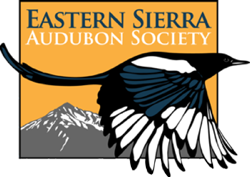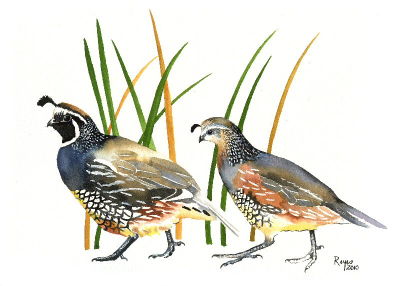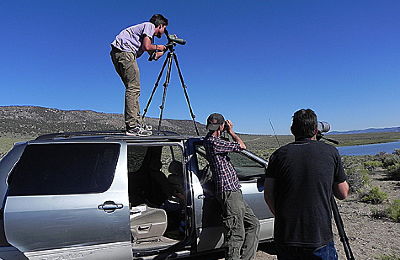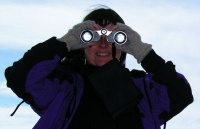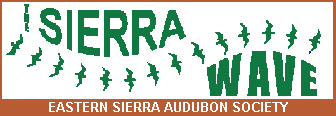
Eastern Sierra Audubon
Sierra Wave Newsletter
Volume 30, Number 1
September-October, 2011
Contents
- Events:
- Features:
- Reports:
- Business
Events
A Prime time for an East African Safari!
Spectacular Photography from Ed and Pat Nahin’s 2010 Ecology Safari
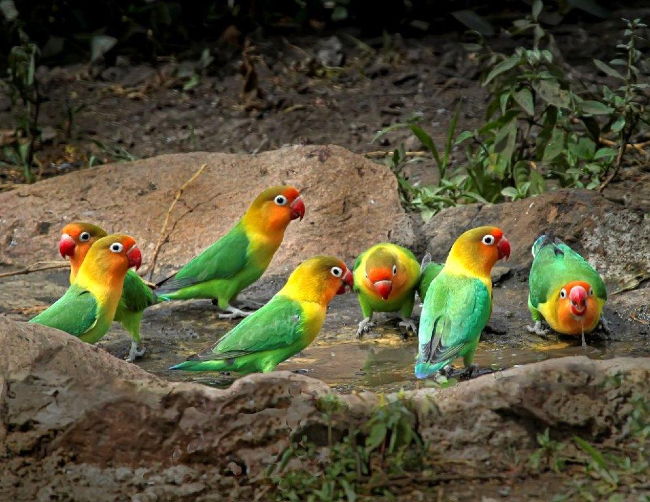
Yellow-collared Lovebirds, Serengeti, Photo by Ed Nahin
(click on the photo for a larger version)
On Wednesday, October 5th, 2011, Ed and Pat Nahin will do a presentation of images from their African travels. They have made approximately 10 photo safaris to Africa to photograph wildlife. Ed has a great eye and his current Africa show has expanded photography of birds. Note that this is the FIRST Wednesday of the month (for those of you who are used to programs occurring on the second Wednesday).
Edward Nahin is a well-known and published wildlife, nature, and portrait photographer who participates in local photography activities and leads photographic tours in the Eastern Sierra. His passion for nature and photography has taken him to many remote locations around the world which most people don’t get to see. Frequent trips with his wife and fellow photographer, Pat Nahin, to Africa, Antarctica, the Arctic and many other regions have provided him with thousands of magnificent images to share.
Eastern Sierra Audubon enjoyed a fantastic slide show of their travels to Antarctica in December 2009, and we look forward to their current show of African wildlife, from their 2010 travels in Tanzania and Kenya. Ed’s photography is a design of beauty and excitement. The spectacular images stay with you long after you view the show.
Program will be held at White Mountain Research Station at 7pm on Wednesday, October 5th, 2011 - all are welcome. Don’t miss this fantastic show!
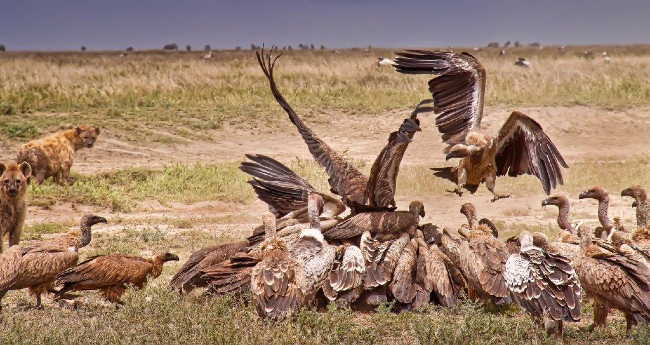
African White-backed Vultures vie with spotted hyenas for carrion, photo by Ed Nahin
(click on the photo for a larger version)
More 2011-2012 programs to put on your calendar:
December 7th, 2011: Alpine Lake Biology (after Christmas Candlelit Dinner)
Roland Knapp of Lee Vining, the preeminent amphibian biologist in the Sierra, will do a program on the biology of Alpine Lakes. While working on Mountain Yellow Legged Frogs he has also learned lots about Gray Crowned Rosy Finches and Water Shrews among other things. He has great footage of the rebound of Finches in Humphrey’s Basin. Should be a great Christmas program. More details to come....
February 1st, 2012: Reptiles and Amphibians of the Great Basin
Laura Cunningham, who did a program last year that was fantastic on her book, A State of Change, will return to do a program on reptiles and amphibians of the Great Basin. Laura lives near Beatty on a property called the Atomic Toad Ranch, and is an expert on the creatures. She is excited to come back, and it should be a great program. More details to come....
Everyone is welcome to attend all programs!
Back to Top

Birders, Owens Lake Big Day
2011 Owens Lake Fall Big Day - Wednesday, August 24th
Join us for a fun Fall Big Day at Owens Lake. The lake will be surveyed for all birds of all species during the peak of fall migration. Small groups will census every bird habitat at Owens Lake in order to have a ‘snap shot’ of a single day. Expect to see thousands of shorebirds at this Important Bird Area, so be prepared. Past counts have totaled 40,000-60,000 birds!
Meet at 7:00AM at the parking lot of Diaz Lake County Park 3 miles south of Lone Pine on Hwy 395.
To sign up contact survey coordinator Michael Prather at (760) 876-5807 mprather@lonepinetv.com.
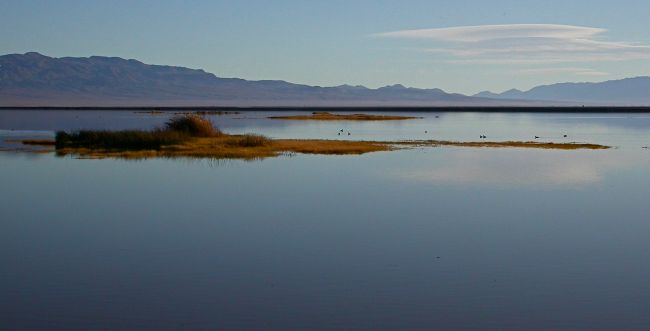
Owens Lake T30 Islands , Photo by Michael Prather
Back to Top
Upcoming ESAS Field Trips
Owens Lake Field Trip, Saturday, September 3rd, 7:30am
Jon Dunn and Michael Prather will be leading this field trip to Owens Lake for Eastern Sierra Audubon and Friends of the Inyo.
It may be summer to us, but many birds which breed or were hatched in northern habitats are passing south in August. A
renewed Owens Lake, where acres of low water are now spread, beckons these long-distance fliers to drop in for a few
meals. Searching for them with co-leaders Michael Prather and Jon Dunn is a valued opportunity; their expertise is certain
to enrich the experience. Bring snacks, sunscreen, hat, binoculars or scopes, and plenty of water.
Meet at Diaz Lake,
adjacent to U.S. 395 just south of Lone Pine at 7:30 a.m. Carpooling is encouraged. For further information contact
Michael Prather at (760) 876-5807 mprather@lonepinetv.com.
Birding Near Mono Lake, Saturday, October
1st
Joint trip with Yosemite Area Audubon Society
Annually, Mono Lake, another one of America’s Important Bird Areas, hosts more than two million shorebirds and waterbirds. We’ll record a few, and visit birding hotspots nearby such as Rush Creek, Dechambeau Ponds and Lundy Canyon.
Participants will meet at 8:30am at Mono Lake County Park north of Lee Vining. Bring lunch, water, warm clothes, binoculars and scopes. For further information please contact Larry Nahm at (760) 872-4125 or Lowell Young at (209) 966-2547.
Rock Creek Birding, Sunday, October 23rd Note New Date: October 30th
What species will be lingering in the mountains this year? Join Bill Mitchel
for this popular annual birding and hiking trip in the high country.
Meet at
the Sno-Park below East Fork Campground on the Rock Creek Road at 9am. Bring
binoculars, water, lunch and warm clothing. Call Bill at 872-4774 for more
info and to check in case location needs to change.
Back to Top
15th Annual Central Valley Birding Symposium
The Central Valley Bird Club will be hosting the Fifteenth Annual Central Valley Birding Symposium Nov. 17-20, 2011 at the Stockton Hilton Hotel in Stockton, CA. Please come and help us kick off this year’s CVBS! Come meet the CVBS board & staff members! Reconnect with old friends! Meet new ones! Take advantage of the scrumptious Hors D’oeuvres buffet & No Host Bar on Thursday night.
Thursday Night Keynote speakers are: Ed Harper & John Sterling presenting a program on “Appreciating the Birds of the Central Valley.” Come sit back and watch as Ed & John take us on a photographic journey to catch a glimpse of the avian world of the Central Valley.
Friday Night’s keynote program is presented by Ron LeValley on “The Writings of William Leon Dawson—a California Bird Pioneer.” Dawson’s writings are humorous, sad, spiritual, satirical, and inspirational. Ron’s presentation and photography captures much of this feeling.
Saturday Night’s keynote program is by Jeff Gordon on: “10 Birds that Changed Birding.” There is the “spark” bird--the one that turned you from a casual observer into an avowed birdwatcher, willing to endure long miles and early hours in search of new species. There are birds that thrilled you with their rarity, their beauty, and their unexpected behaviors. Come hear what Jeff has to say.
Other events include workshops on Swallow ID Workshop by Joe Morlan & a Warbler ID Workshop by Jon Dunn. There are also programs on topics of Bird Migration & Wetlands Icons.
Our field trips always turn up exciting birds. Add in the always entertaining and educational Bird ID Panel, the wonderful display of art and gifts for yourself or others at the Birder’s Market and the camaraderie of hundreds of like-minded folks, and you know you’ll have a good time! There’s something for everyone interested in birds. Come and join us to bird, learn, and just have fun!
The schedule, brochure, registration form, etc. have just been updated on the website at: http://cvbs.org
Back to Top
Articles
President’s Message
“We are confronted by insurmountable opportunities.”
— Pogo
Summer thoughts
As always, I really enjoyed this year’s Mono Basin Bird Chautauqua. Its timing, in June, ushers in the summer with long days and, this year at least, warm sunny days. And a great deal of water. Lee Vining is a really neat community; it is always a treat to talk with the Mono Lake Committee folks and it is nice to be in the midst of lots of like-minded people.
This year there were friends in each of the workshop/trip groups I was in. Not just people I recognized or had seen in prior years, but people I have worked with, talked with, birded with and whose company I really value.
I was really struck by how much the presence of these people added an extra dimension
to these field trips. (Leave it to me to take years to discover the obvious.) My memories of this year are not so much the bird I saw and the things I learned about them, but rather the sense of sharing of experience. I think of a wide-ranging conversation that took place while following animal tracks through the sage toward a raging Lee Vining creek, talking about family in the shade of a newly leafed aspen grove and discovering a whole new dimension in someone as we spent a half hour looking at nesting Osprey. My thanks go to the people with whom I shared the weekend.
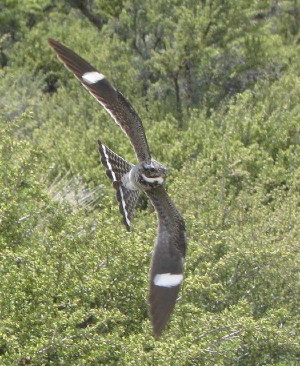
Common Nighthawk at Black Point, June 2009
Photo by Justin Hite
Summer twilight brings nighthawks and bats to our yard. I didn’t think of our landscaping as an insect factory, but I was wrong about this. Unseen by me, these little packets of protein supported two nests of phoebes through successful fledging and now support an aerial show in the fading daylight. I really look forward to seeing the nighthawks and their curious wing angle, white stripe, and distinctive pattern of flight. At the first call, I drop what I am reading to watch them swoop through the yard.
A friend of mine who works for fish and game tells me about conducting bat surveys in the White Mountains. My mind’s eye pictures roosts of bats in the cool darkness or abandoned mines. The product of someone’s dreams of riches now shelter bat families. Do my bats live in the Whites and wait through the heat to come down into the valley and feed? Where are these nighthawks during the day; during the winter? More mysteries to consider while sitting on the patio.
It was quite a spring and summer for babies out here. In addition to our two phoebe nestlings, we had lots of baby quail, tiny lizards and are overrun with squirrels and rabbits.
The phoebes set up shop right on the patios and we watched daily for a month or so as these eggs actually turned into birds. The nest brought the gift of a free alarm clock whether we needed one or not. Chirping began at first light and didn’t stop until actual night. What a huge amount of work for the adults who were really conscientious about dividing the food supply among the babies. I know I had nothing to do with any of this; but these are my birds and I am grateful for their presence.

Summer is not over, but Eastern Sierra Audubon is already at work on the program year for 2011 -2012. “The little chapter that could” has a full range of activities coming up. We will be sponsoring field trips in both Inyo and Mono counties featuring top locations and really accomplished trip leaders. Trips are constantly being added, so keep current with our website for details. Our membership programs will bring you the chance to view striking images of African wildlife, learn about alpine biology, water and frogs, get to know the reptiles and amphibians of the Great Basin and a chance to check out beautiful photographs of unusual birds. And don’t forget the annual holiday dinner.
I encourage you to participate in the Christmas Bird Count and support that chapter by making a pledge as a part of the CBC Bird-a-thon. Also, be a part of the Backyard Bird Count next spring.
The chapter will continue to work through the Owens Lake Master Plan process toward an outcome which guarantees a robust natural habitat for the lake’s amazing bird populations.
When spring rolls around (if we have one next year), the chapter will once again partner with local gardeners to present “Wild at Home” to encourage people to create wildlife friendly spaces in their home landscapes, and we will continue to bring the great “Birds in the Classroom” program into local elementary schools.
All of this happens because of the work and dedication of our gifted board members, committee and project chairs and other volunteers. Again and again, these folks step up and get things organized, set up, taken down, publicized and all the other things that are required to keep the chapter and its activities afloat. Check out our website (and Facebook page!) on a regular basis to keep up with what is happening. (Big thank you to Chris Howard, Maggie Wolfe Riley and Serena Dennis for minding our “electrical store.”) There is always room for another set of hands or binos, so please come join us.
Pete Pumphrey
Back to Top
Feature: Surprises from Spring
Spring 2011 in Inyo County
By Tom & Jo Heindel
Click on any of the photos for a larger version (may take a little while to show up, depending on your internet connection speed). In addition, text links show photos of the recorded bird (all included in slideshow)
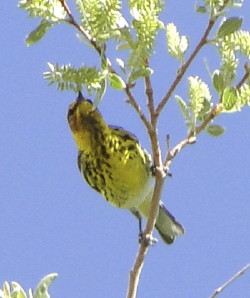
Cape May Warbler,
Birchim Canyon,
Photo by Nancy Overholtz
Each season brings surprises, questions, concerns, and disappointments and this past spring was no exception. We enjoyed some major surprises with species showing up that hadn’t been recorded in decades and some major disappointments with what did not show up.
A Cape May Warbler at Birchim Canyon 14 May (J&DP, BJK) was seen by many and documented with digital images and video. Only two Cape May Warblers have been seen since 1978 with one in 1991 and the other in 1996. Two days later a male Canada Warbler was documented in Saline Valley (ADeM). This is only the second record in Inyo County in the last 20 years. A male Golden-winged Warbler was in Birchim Canyon 2 June (J&DP) and was seen by many birders and well documented. This is only the second record in the county since 1979. A Common Grackle (inappropriate name in the West!) visited a Big Pine yard 4 June, remained briefly but long enough for images to be taken (T&JH). The Golden-winged Warbler and Common Grackle are so rare in the state that the California Bird Records Committee will review the sightings and we await their decision.

Golden-winged Warbler,
Photo by Debby Parker
The surprising disappointments were that our expected eastern vagrants, species that wander out West regularly, went unrecorded. American Redstart, which in the 1970s had multiple daily counts of eight birds at one location on one day by one party, was not detected until after the spring season ended. Northern Waterthrush was not observed at all and Black-and-white Warbler failed to appear until the summer season arrived. We recall a trip to Texas in 1994 when we had Indigo Buntings everywhere. The Laguna Atascosa Wildlife Refuge manager told us that he had never seen anything like it in the decades he had worked there. When we got to Louisiana State University, we told the story to the curator of ornithology, Dr. J.V. Remsen and he was relieved, noting that they had almost none that spring. The great unknown is what causes these changes, are they permanent or just an oscillation, or the result of other unknown events.
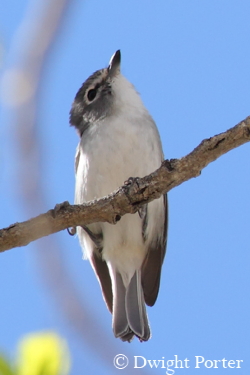
Plumbeous Vireo,
China Ranch,
Photo by Dwight Porter
Other very rare or casual species recorded this spring were a photographed Chestnut-sided Warbler at Taboose Creek 22–23 May (J&DP), a photographed Least Flycatcher at Independence 29 May (DAB et al.) and a photographed Ovenbird the same day and place (DAB), a well described Common Moorhen at Tinemaha Reservoir (JMcK) and another individual photographed at Furnace Creek Ranch 29 May (C&RH), a photographed California Towhee northwest of Big Pine 23 May (J&DP), a female Bronzed Cowbird photographed at Shoshone 14 May (LSW, MHH), a well described male Baltimore Oriole at Birch Creek 9–12 May (JEB, SMcL), a photographed White-winged Dove in Bishop 4 June (CBH) and a first wintering record of a Plumbeous Vireo photographed at China Ranch 7 March –1 April (DSP, TSH).
Multiple Lawrence’s Goldfinches were reported from Little Lake (DBW), Independence (J&DP et al.), and Bishop (C&RH) and all sightings were photographed. Exciting was the discovery of a Vermilion Flycatcher family photographed at Furnace Creek Ranch 29 May (C&RH). This was the first documented breeding record for Death Valley National Park and only the second breeding record for Inyo County.
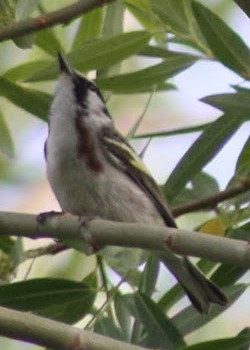
Chestnut-sided Warbler, Taboose Creek
Photo by Rosie Howard
Twenty-seven Swainson’s Hawks, reported near Laws 3 April (J&DP), were the only large flock reported in the county since a flock of 34 birds was discovered near Big Pine 19 June–4 July 1991. After a five-year absence, Cassin’s Kingbirds were once again nest building at Deep Springs College 14 May (C&RH). More than a dash of color was added with nine Summer Tanagers (Aspendell to Amargosa Canyon) and one well-described male Rose-breasted Grosbeak at Birch Creek 21 May (JEB, SMcL) rounding out a spectacular spring.
Again, our kudos and respect to this special cadre of birders who enjoy the challenge of providing enough evidence of their claims to turn personal sightings into reliable county records.
- ADeM - Al DeMartini
- BJK - Barb Kelley
- C&RH - Chris (CBH) & Rosie Howard
- DAB - David Bell
- DBW - Doris Wartman
- JEB - Jan Bowers
- JMcK - JoAnne McKenzie
- J&DP - Jim and Debby Parker
- LSW - Len Warren
- SMcL - Steve McLaughlin
- T&JH - Tom (TSH) & Jo Heindel
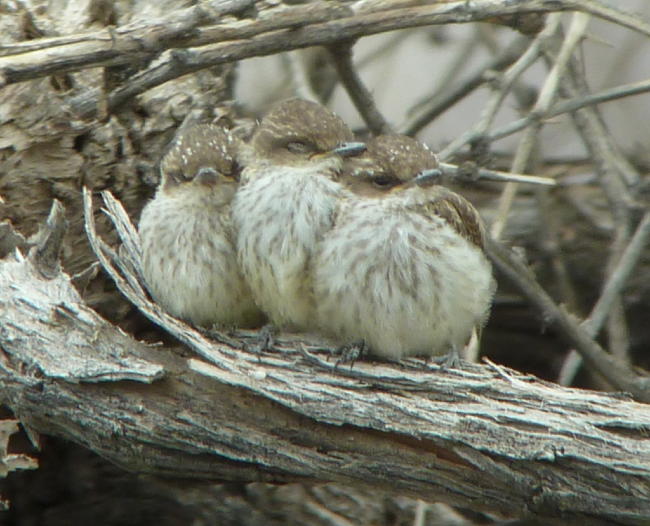
Vermillion Flycatcher “family photo,” Furnace Creek, Photo by Chris Howard
Back to Top
Reports
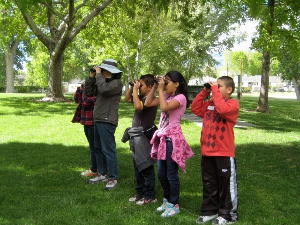
Kay with students in Bishop City Park
Birds in the Classroom
We had a very successful “Birds in the Classroom” Program last May. All 3rd grade students at the Bishop elementary school and some classes in Benton participated in the program to go birding during migration. As part of the lesson, students were acquainted with the common birds of the Owens Valley, taught about different adaptations for survival, and given an overview of bird migration.
Eastern Sierra Audubon provided child-size binoculars for each student and volunteers trained the students in their proper use. This year in Bishop, students also had practice with binocular and birding skills in their art classes with Rosie Howard. Then, just prior to the field trips, Audubon volunteers presented slide and video shows in their classrooms about different birds’ adaptations for survival and about bird migration. At this time students had an opportunity to ask questions and discuss what they knew about birds. Many students had lots of comments! Then each class of students had a one-hour birding session in the Bishop City Park with Audubon volunteers during spring migration, giving students the best possibility of viewing of birds. The students in the park were elated to see Western Tanagers, which they had just drawn and painted in their art classes the week before!
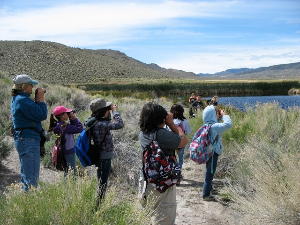
Kathy working with students in Benton
This year the Audubon volunteers meeting the Bishop students in the park were Kathy Duvall, James and Kay Wilson, Todd Vogel, Bill Mitchel and Larry Nahm.
Hilary Behr from the Eastern Sierra Land Trust and Kathy Duvall also went to Benton to work with the students there. The students really enjoyed seeing the Ruddy Duck with his blue bill and his brightly colored breeding plumage out at the ponds in Benton.
Thank you to everyone for all the help and support!
Volunteers are always welcome to help with the 3rd grade field trips. Please contact Sara Steck at 873-4320 if you are interested in helping out with this great and fun learning experience for our local students next spring!
Sara Steck
Back to Top
Field Trip Reports
Mono Lake County Park and Lundy Canyon Birding, June
3, 2011
Evening Grosbeaks! Only the early birds among the thirteen enthusiasts
who assembled at the county park got to see this irregular species, but leader
Dave Marquart, an expert in birding by ear, led us to much else among the cottonwoods
and aspens. Highlights included Brown Creeper, Warbling Vireo, Cedar Waxwings,
Hermit Thrush and Red-breasted Sapsucker. The many Yellow Warblers, said Dave,
thrive here now that riparian habitat restoration has been undertaken. In Lundy
Canyon most aspens had not yet leafed out, yet we noted a pleasing variety.
Yellow-rumped Warblers and Fox Sparrows sang, Pewees flitted, a pika squeaked.
Above the beautiful beaver ponds, five Sierra Nevada bighorn traversed rocky
slopes. All attendees, from first-timers to veterans, benefited from Dave’s
experience and example.
Middle Fork Bishop Creek Birding, May 22, 2011
The critters were
there, but only four pairs of eyes and ears were recording as we easily worked
our way across some snow and swampy areas covering the trail not far below
Lake Sabrina. In the bare choirs of an aspen grove Violet-green Swallows tended
a nest-hole. Fox Sparrows sang atop conifers. A Hermit Thrush gave the beady
eye. The enjoyable morning loop yielded twenty species, including Cassin’s
Finches, Red-breasted Sapsuckers (very common here), creepers, Townsend’s Solitaire
and Mountain Bluebirds.
Larry Nahm
Back to Top
Mono County Big Day: 151 Species!
Re-posted from the Eastern Sierra Birds Google Group
We’d been talking about doing a Big Day in Mono County all summer. We hadn’t done any real scouting, so July 12th was supposed to just be a trial run and we were hoping to maybe get close to the previous Mono County record of 135.
We birded from 3am to 11pm. We (the “we” being Nora Livingston, Oliver James, Chris McCreedy and myself) started at Fish Slough, then trekked through Chalfant, Benton, the Benton Range, Black Lake, Wild Rose Canyon, Crowley, the road to Minaret Summit, the Mammoth Lakes Scenic Loop, the June Lake burn, Lee Vining Canyon, the Warbler Thicket, Virginia Lakes, Bridgeport Reservoir, Twin Lakes, Warford Spring, DeChambeau Ponds and County Park.
It’s hard to sit here and try and think of highlights because there were just so many. Our first bird was a Short-eared Owl and our last was a Long-eared. Blue Grosbeaks and Le Conte’s Thrashers were keeping things spicy in Fish Slough. A male Ring-necked Pheasant was trying to hide in short grass at the White Mountain Ranch. Golden Eagle standing like a lazy tyrant on a pile of boulders in the Tablelands. Gorgeous female Red-necked Phalarope slumming with Least Sandpipers at Black Lake. Red-naped Sapsucker paired with Red-breasted at Wild Rose, where we also got beautiful looks at a Virginia’s Warbler, the cocky crest of a Juniper Titmouse and the gorget of a Calliope. Sage Grouse hanging out with a Willet on the shore of Crowley, where we also had a scruffy looking Common Loon and a distant flying Black Tern. A spectacular moment in the forest a little below Minaret Summit with a tame Pine Grosbeak and both species of Kinglets singing like the world was about to end. Red Crossbill pair drinking from a creek on the scenic loop... Chris wondered if they drink sideways.
We tied the old record with Lazuli Bunging and broke it with Indigo Bunting at the Warbler Thicket. Flyover Rosy Finch at Virginia Lake, which is also where, halfway through wondering aloud if there were Bighorn Sheep on the talus slopes, I interrupted myself to shout “Bighorn on the talus!” Three Sandhill Cranes, a pair and a single, wandering around the south shore of Bridgeport. Our final daytime bird was Common Mergansers at Twin Lakes that waited in hiding until we were deciding to leave, then popped out to wish us good riddance. And we were a bit worried when a Sheriff with lights flashing pulled up behind us outside the Conway Ranch Fish Hatchery gate wondering what kind of misdeeds we were committing, and after laughing at our explanation suggested a better spot for owls at Warford Spring. So we went out there and were greeted by the adorable peeping of a Long-eared Owl fledgling the moment we stepped out of the car.
Below is the complete list. We all saw new county birds and there were even a few life birds in there. I added a note to birds if they were a life or county bird (CB) for any of the crew.
- Common Loon
- Eared Grebe
- Pied-billed Grebe
- Western Grebe
- Clark’s Grebe (CB Chris)
- American White Pelican
- Double-crested Cormorant
- Great Blue Heron
- Great Egret
- Black-crowned Night-Heron
- White-faced Ibis
- Canada Goose
- Mallard
- Gadwall
- Northern Pintail
- American Wigeon
- Northern Shoveler
- Cinnamon Teal
- Green-winged Teal
- Redhead (CB Nora)
- Ring-necked Duck
- Common Merganser
- Ruddy Duck
- Turkey Vulture
- Northern Harrier
- Red-tailed Hawk
- Swainson’s Hawk
- Golden Eagle (CB Nora)
- Osprey
- American Kestrel
- Prairie Falcon
- Greater Sage-grouse
- California Quail
- Ring-necked Pheasant (CB Nora, Justin, Chris, Oliver)
- American Coot
- Virginia Rail (CB Nora)
- Sandhill Crane (CB Chris)
- Killdeer
- American Avocet
- Greater Yellowlegs
- Spotted Sandpiper
- Willet
- Long-billed Curlew
- Least Sandpiper
- Wilson’s Snipe
- Wilson’s Phalarope
- Red-necked Phalarope
- Ring-billed Gull
- California Gull
- Caspian Tern
- Black Tern
- Mourning Dove
- Eurasian Collared-Dove
- Rock Pigeon
- Long-eared Owl
- Short-eared Owl (CB Nora)
- Great Horned Owl
- Common Nighthawk
- Common Poorwill
- Costa’s Hummingbird
- Calliope Hummingbird
- Rufous Hummingbird
- Lewis’s Woodpecker
- Red-naped Sapsucker
- Red-breasted Sapsucker
- Williamson’s Sapsucker
- Hairy Woodpecker
- Black-backed Woodpecker
- Northern Flicker
- Western Wood-Pewee
- Dusky Flycatcher
- Gray Flycatcher
- Say’s Phoebe
- Ash-throated Flycatcher
- Western Kingbird
- Loggerhead Shrike
- Plumbeous Vireo
- Warbling Vireo
- Steller’s Jay
- Western Scrub Jay
- Pinyon Jay
- Clark’s Nutcracker
- Black-billed Magpie
- American Crow (CB Nora)
- Common Raven
- Horned Lark
- Violet-green Swallow
- Northern Rough-winged Swallow
- Bank Swallow
- Tree Swallow
- Cliff Swallow
- Barn Swallow
- Juniper Titmouse
- Mountain Chickadee
- Red-breasted Nuthatch
- White-breasted Nuthatch
- Brown Creeper
- Bewick’s Wren
- House Wren
- Marsh Wren
- Rock Wren
- American Dipper
- Golden-crowned Kinglet
- Ruby-crowned Kinglet
- Blue-gray Gnatcatcher
- Townsend’s Solitaire
- Mountain Bluebird
- American Robin
- Hermit Thrush
- Northern Mockingbird (CB Nora)
- LeConte’s Thrasher (life Nora, CB Justin, Oliver)
- Sage Thrasher
- European Starling
- Orange-crowned Warbler
- Virginia’s Warbler
- Yellow Warbler
- Yellow-rumped Warbler
- MacGillivray’s Warbler
- Common Yellowthroat
- Western Tanager
- Lazuli Bunting
- Indigo Bunting
- Blue Grosbeak (CB Nora, Chris, Oliver)
- Black-headed Grosbeak
- Spotted Towhee
- Green-tailed Towhee
- Black-throated Sparrow (CB Nora)
- Brewer’s Sparrow
- Vesper Sparrow
- Sage Sparrow
- Chipping Sparrow
- Savannah Sparrow
- Fox Sparrow
- Song Sparrow
- Dark-eyed Junco
- White-crowned Sparrow
- Bullock’s Oriole
- Western Meadowlark
- Red-winged Blackbird
- Yellow-headed Blackbird
- Brewer’s Blackbird
- Great-tailed Grackle
- Brown-headed Cowbird
- Red Crossbill
- Pine Grosbeak (life Chris, CB Nora)
- Gray-crowned Rosy-Finch
- House Finch
- Cassin’s Finch
- Lesser Goldfinch
- Pine Siskin
- House Sparrow
Justin Hite
Back to Top
Taking Care of Business
Welcome New and Renewing Members!
Eastern Sierra Audubon would like to thank the following new and/or renewing members for their support:
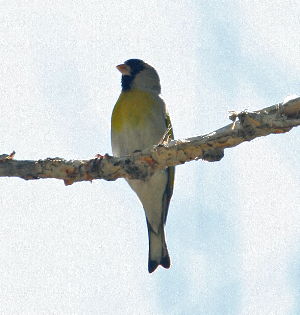
Lawrence’s Goldfinch
Photo by Jo Heindel
- Gebby & Cathy McMurry
- Laura Finney
- Peter Hoijer
- Diane Nicholson
- France & Alice Davis
- Stanley Kleinman
- Pamela Stones
We would also like to especially thank all the renewing members whose donations help keep this chapter alive! We get 8-10 renewing members a month, and from 3-5 new members. Your membership dues make it possible for us to offer and support great educational and recreational events throughout the eastern Sierra.
If you would like to join and help support Eastern Sierra Audubon, there are two ways you can do it:
- Join as a National Audubon Society Member, designating ESAS as your chapter affiliation. Includes Audubon Magazine subscription. This is $20 for the first year, and goes up to $35 annually thereafter.
- Join as an ESAS Chapter-only member for $20 per year. Now that we do the newsletter online, you no longer need to join to receive it, but your chapter membership is a way to give back, and show your appreciation for all that ESAS does, and to help support our many programs.
Click Here for a membership form to join or renew!
Join National Audubon - your zip code will associate you with the chapter nearest you.
Back to Top
How You Can Help ESAS: Four R’s (and a V)
Renew your membership (or join): The money from your membership dues is what helps us bring great evening programs, special events, educational programs, trips, this website, and more to the community - we need your support!
Recycle at Manor Market and tell them to donate the money to Eastern Sierra Audubon.
Respect property and get permission to bird on private or restricted access property.
Repeat: Spread the word about programs and events, encourage others to join and participate.
Volunteer: Come to a board meeting and consider volunteering for an open board position! We need a vice president, program coordinator, and we always need volunteers for Birds in the Classroom, participants in bird counts, Bird-A-Thons, etc.
Message from the Editor
Summer is going!
Summers here in the Eastern Sierra are so full and wonderful, and fly by so
quickly. I hope everyone has made the most of this summer, and of course, we
have at least two more months of great outdoor weather before the temperatures
begin to seriously drop, so if you haven’t, you still have time to get outside!
Our next newsletter deadline will be October 25th for the
November-December issue. You are welcome to send submissions for future newsletters
and also the monthly email at any time.
We send out no more
than one email each month to remind you of upcoming events - if you are not
on our email list, please
add yourself so you don’t miss anything! If you send items to the newsletter
editor by the last week of any month, we’ll make sure they get included in
the next issue.
Please Contribute!
Speaking of sending in items for the newsletter...
All of our content is supplied by our awesome members... if you have any ideas about articles you’d like to see, or better yet, if you have anything to share for newsletter publication, whether an article, a news item, update, correction, poem, essay, artwork, photo, field trip report, neat birding experience, letter, etc, please send it, along with any comments or suggestions, to the newsletter
editor. We’d love to hear from you!
You may send items for inclusion in the newsletter at any time, but please
send any timely items to arrive before the first of the month, so they can
be included in the monthly email update.
Thanks for reading, and happy birding!
Maggie Wolfe Riley, Newsletter Editor
Back to Top
About Eastern Sierra Audubon
Current Board Members
Membership
Main Calendar of Events
Calendar for August, September and October
Back to Top
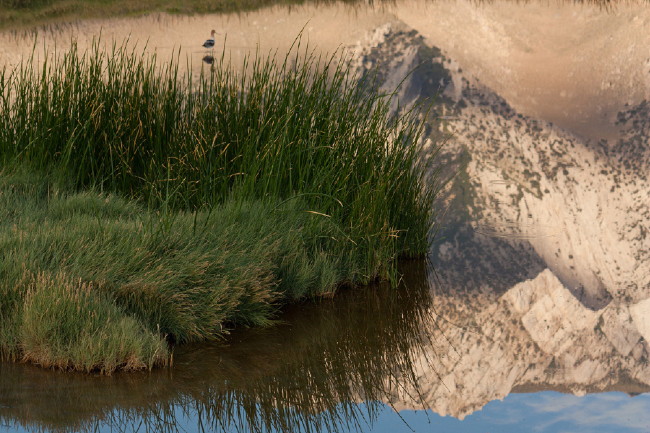
American Avocet with Sierra reflections at Cartago Springs on Owens Lake
Photo © Scott Palamar
